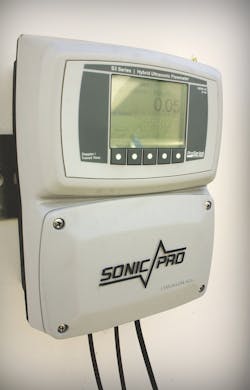Flowmeter Helps Maintain Food-to-Microorganisim Balance in Return-Activated Sludge Line
Keene Wastewater Treatment Plant (WWTP) uses a secondary treatment process called activated sludge, a process that converts non-settleable substances into biological floc. This substance is developed in aeration tanks and settled out in final settling tanks.
Activated sludge is an aerobic process that promotes the health of microorganisms, ensuring effective treatment. A food-and-oxygen-to-microorganism balance must be maintained for optimal treatment. One element of maintaining the biomass requires returning a portion of the settled sludge from the final settling tanks back to the aeration tanks, keeping the bio system balanced. This portion of the activated sludge is referred to as return activated sludge (RAS). The RAS is returned to the aeration tanks via variable-speed centrifugal pumps, where accurate flow rate measurement is critical to ensuring that a proper food-to-microorganism ratio is maintained. The RAS flow rate is determined by laboratory analysis of the microorganisms’ health, and the flow rates are adjusted accordingly.
High Variance
This past summer, employees of the Keene WWTP required a flowmeter for flow measurement on an existing 18-ft ductile iron RAS line with the capability of a 4-20 mA signal. Previously, a magnetic flowmeter had been selected for the job; however, they were getting a high variance in readout measurements. It was determined that stray electrical interference currents were causing the inaccurate readings. Due to its failure in accuracy, Keene WWTP sought an alternative that could handle the job. Because ultrasonic flowmeters only measure sound waves, the electrical interference would not hinder their performance.
Transit-Time Solution
The Blue-White Sonic-Pro S3 hybrid ultrasonic flowmeter proved to have all the capacities necessary for the task. Utilizing the dual Z-Mount T-Track mounting system, installation of the flowmeter was completed within 60 minutes. This external mounting system’s built-in ruler guaranteed the sound wave transducers were perfectly lined up and spaced, while the alignment rods connecting the two T-Tracks ensured the tracks were 180 degrees opposite of one another. With an easy-to-follow instruction guide, the electronics were configured quickly to accurately measure the flow of the RAS pipe using the transit-time method of flow measurement, the alternative in this hybrid meter being the Doppler method for a higher particulate count.
When operated in the transit-time measurement method, a short ultrasonic signal burst passes first in one direction and then in the other, between two transducers separated along the length of the pipe. When traveling in the same direction as fluid flow, the burst is carried by the fluid and arrives earlier as a result. When traveling against fluid flow, the burst is held back by the fluid and arrives later. The signal processing unit measures this difference in time of flight in the two directions. From this—the actual times of flight, the distance traveled in the fluid, and the angle of the ultrasonic signal path—fluid velocity is calculated. This method of measurement requires relatively “clean” fluid, containing less than 10% particulates (or less than 100,000 ppm), to enable sound waves to complete a circuit. To adjust for changes in the fluid’s particle count, the Sonic-Pro monitors the signal gain and employs an automatic gain control algorithm, which periodically adjusts to maintain optimum signal power.
The reliable flow measurement of Blue-White’s Sonic-Pro ultrasonic flowmeter was successful in solving the Keene WWTP’s system requirements, without intrusive equipment or altering of the existing pipeline.
Download: Here
